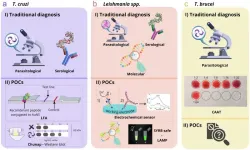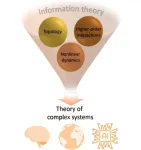(Press-News.org)
Introduction
Neglected Tropical Diseases (NTDs) remain a significant health burden in tropical and subtropical regions, with limited treatment options and diagnostic capabilities. These diseases are often neglected in research and policy, yet they contribute to high mortality and morbidity worldwide. Nanotechnology, particularly the conjugation of nanomaterials with drugs, presents an innovative approach to improving both the diagnosis and treatment of these diseases. Nanomaterials have unique properties that allow for enhanced drug delivery, reduced toxicity, and more precise targeting, making them a promising tool in the fight against NTDs.
Nanomaterials for Diagnostic and Therapeutic Applications
Nanomaterials offer significant advantages due to their small size, high surface area-to-volume ratio, and the ability to be engineered for specific applications. These materials can interact at the molecular and cellular levels, enabling targeted delivery of therapeutic agents to diseased tissues, which is crucial for treating parasitic infections. The large surface area of nanomaterials allows for the encapsulation of drugs, peptides, and genetic materials, protecting them from degradation and allowing for controlled release over time. This targeted delivery minimizes systemic toxicity, a significant challenge associated with conventional treatments.
Moreover, nanomaterials can be designed to possess specific chemical functionalities, enhancing their ability to target pathogens or diseased cells with high precision. This reduces the negative impact on healthy tissues and improves the overall safety profile of treatments. Nanotechnology also offers opportunities to develop theranostic platforms that combine diagnostic and therapeutic functions, allowing for early disease detection and personalized treatment.
Addressing the Challenges of NTDs
NTDs, including diseases such as Chagas disease, leishmaniasis, and sleeping sickness, are often caused by parasites that are difficult to treat due to their complex life cycles and ability to develop resistance to drugs. Current treatments are often associated with severe side effects and limited efficacy. Nanomaterials conjugated with drugs represent an effective strategy to overcome these challenges. By improving drug delivery and enhancing the bioavailability of therapeutic agents, nanotechnology can make existing treatments more effective and safer.
For instance, in Chagas disease, nanocapsules containing antitrypanosomal agents like LYC have been developed to increase drug stability, reduce toxicity, and improve therapeutic efficacy. Similarly, nanomaterials are being explored to enhance the treatment of leishmaniasis and sleeping sickness by improving drug penetration and targeting infected tissues more precisely.
Innovative Diagnostic Tools
In addition to therapeutic applications, nanomaterials play a crucial role in improving the diagnosis of NTDs. Traditional diagnostic methods for these diseases are often invasive, time-consuming, and lack sensitivity. Nanotechnology offers the potential for rapid, sensitive, and cost-effective diagnostic tools. Gold nanoparticles (AuNPs), for example, have been used in point-of-care tests (POCs) for diagnosing Chagas disease and leishmaniasis. These biosensors can detect disease-specific biomarkers with high sensitivity and specificity, allowing for early detection and timely intervention.
Future Directions
The future of nanotechnology in NTD management lies in the continued development of nanomaterial-drug conjugates. Future research should focus on optimizing the design of these conjugates to improve pharmacokinetics, bioavailability, and drug stability. Additionally, efforts should be made to develop targeted delivery systems that can address specific NTD pathogens or infected tissues, thereby reducing off-target effects and improving therapeutic efficiency.
Collaboration between researchers, clinicians, and industry stakeholders will be essential for translating nanotechnology innovations from the laboratory to real-world applications. Furthermore, addressing the ethical, regulatory, and cost-related challenges associated with nanotechnology adoption in low-resource settings will be crucial to ensure equitable access to these advancements.
Conclusion
Nanomaterial-drug conjugates offer a transformative approach to the treatment and diagnosis of NTDs. By enhancing drug efficacy, minimizing toxicity, and enabling targeted delivery, nanotechnology holds the potential to revolutionize the management of these diseases. The integration of nanomaterials with drugs represents a promising frontier in global health innovation, paving the way for more effective and sustainable solutions in combating neglected tropical diseases worldwide.
Full text
https://www.xiahepublishing.com/2572-5505/JERP-2024-00007
The study was recently published in the Journal of Exploratory Research in Pharmacology.
Journal of Exploratory Research in Pharmacology (JERP) publishes original innovative exploratory research articles, state-of-the-art reviews, editorials, short communications that focus on novel findings and the most recent advances in basic and clinical pharmacology, covering topics from drug research, drug development, clinical trials and application.
Follow us on X: @xiahepublishing
Follow us on LinkedIn: Xia & He Publishing Inc.
END
INDIANAPOLIS – It is important that a healthcare team is aware of and understands a patient’s goals of care, both medical and personal. But that information, if documented, typically is not placed in a standardized location and is difficult to find within a patient’s voluminous electronic health record (EHR).
A new study by researchers from Regenstrief Institute, the Indiana University School of Medicine and Indiana University Health presents the standardized goals of care note they developed, deployed and evaluated as a quality improvement initiative at ...
New research found that supplementing maternal diet with α-tocopherol, a form of vitamin E, can reduce the development of food allergy and anaphylaxis in newborn mice.
The prevalence of food allergy in children increased 50% from 2007 to 2021 in the United States (US), with the incidence of peanut allergy tripling in that time. This new study, published in The Journal of Immunology, shows the potential for α-tocopherol in prenatal vitamins during pregnancy and lactation to address this alarming increase and reduce development of food allergy early in life.
The study found that ...
Artificial intelligence (AI) is reshaping workplaces by streamlining routine tasks and boosting efficiency, particularly in retail, where innovation is essential for maintaining a competitive edge. Beyond automation, AI supports employee creativity by offering valuable insights and allowing them to focus on innovative tasks. However, research is limited on how AI service quality impacts employees in retail industries, making this an important area to explore.
Researchers from Florida Atlantic University and Hanyang University in Seoul, South Korea, examined how perceived AI service quality influences retail employees’ ...
One in five older adults gets an infection up to six months after heart surgery — with women far more likely to develop one, according to studies led by Michigan Medicine.
The two studies examined thousands of cases involving Medicare beneficiaries who underwent coronary artery bypass grafting, also known as CABG or heart bypass, or aortic valve replacement.
Women had 60% greater odds of developing postoperative infections, the three most common being urinary tract, pneumonia and sepsis.
Black patients also had higher rates of overall infection (28%) ...
DALLAS, Feb. 19, 2025 — The conditions in which we are born, live, learn, work, play and age — the social drivers of health — are better predictors of health and life expectancy than our genetic code. In communities nationwide, people living in locations just a handful of miles apart can have a dramatic difference in life expectancy.
To help level the playing field, the Grubhub Community Fund awarded the American Heart Association® Social Impact Funds a $2 million grant to support food security, technology innovation and economic resiliency in New York City and Chicago.
“We are grateful ...
COLUMBUS, Ohio – Generic drugs manufactured in India are linked to significantly more “severe adverse events” for patients who use them than equivalent drugs produced in the United States, a new study finds.
These adverse events included hospitalization, disability, and in a few cases, death. Researchers found that mature generic drugs, those that had been on the market for a relatively long time, were responsible for the finding.
The results show that all generic drugs are not equal, even though patients are often told that they are, said John Gray, co-author of the study and professor of operations at The Ohio State University’s ...
Shareholders play a crucial role in corporate governance by voting on key decisions in the companies they invest in. To enhance transparency, regulatory bodies worldwide—such as government agencies and stock exchanges—are increasingly implementing guidelines to hold institutional investors accountable for their voting behavior and ensure they fulfill their fiduciary duties.
A study published in the journal Corporate Governance: An International Review on 22 January 2025 demonstrates that these regulations, even if non-binding, can encourage institutional investors to play a more active role and improve corporate governance. The study, conducted ...
Procedure is simple and could be adopted by most U.S. hospitals
Roughly 2 million people in the U.S. live with limb loss; number is expected to rise
Senior author, a retired U.S. Army colonel, traveled to Ukraine to set up the study
CHICAGO --- A reliable method to treat post-amputation pain remains elusive, but a new Northwestern Medicine study conducted in collaboration with Ukrainian physicians suggests that hydrodissection — a simple procedure that injects fluid around nerves — may reduce residual limb pain and opioid dependence.
The ...
(Embargo: 19 Feb, 10am GMT) A groundbreaking study led by Professor Ginestra Bianconi from Queen Mary University of London, in collaboration with international researchers, has unveiled a transformative framework for understanding complex systems. Published in Nature Physics, this pioneering study establishes the new field of higher-order topological dynamics, revealing how the hidden geometry of networks shapes everything from brain activity to artificial intelligence.
“Complex systems like the brain, climate, and next-generation artificial intelligence rely on interactions that extend beyond simple pairwise relationships. Our study reveals ...
A new study led by researchers from Oxford Population Health has shown that a range of environmental factors, including lifestyle (smoking and physical activity), and living conditions, have a greater impact on health and premature death than our genes.
The researchers used data from nearly half a million UK Biobank participants to assess the influence of 164 environmental factors and genetic risk scores for 22 major diseases on ageing, age-related diseases, and premature death. The study is published today in Nature Medicine.
Key findings
Environmental factors explained 17% of the variation in risk of death, compared to less than 2% explained by genetic predisposition (as ...



